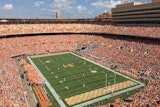
The race to be crowned the fastest human in the world begins long before the super shoes get laced up, the runners take their marks and the starting gun sounds. No world record is possible without one essential element: the track itself.
Eight lanes measuring 200 or 400 meters around may sound like a simple design. However, event organizers, track coaches and venue operators know that a good track — a track where runners set world records — takes years of engineering, designing and testing to change the technology of the ground under athletes’ feet. AB spoke with some of the titans of track and field to understand what goes into creating a cutting-edge track, what it takes to hold a race with the fastest humans on the planet and what track products these professionals look for when taking a facility to the next level.
 Photo courtesy of REGUPOL
Photo courtesy of REGUPOL
Products and facilities
Today’s leading track manufacturers are dedicated to making the innovative products found in state-of-the-art track facilities.
REGUPOL sales director Peter Breuer points to the innovative REGUPOL 4.0 track. “It eliminates the need for a crucial step in the installation process: the sealing of the base mat,” Breuer says. “By removing this step, REGUPOL 4.0 significantly reduces installation time and costs. This makes high-quality running tracks more accessible to a wider range of facilities, and increased durability and a stronger bond between the layers reduces the risk of separation and damage, extending the track’s lifespan.”
Meanwhile, Bo Barber, chief growth and innovation officer at Ecore, takes pride in the company’s commitment to sustainability without sacrificing track quality. She says Ecore’s TRUCircularity program “offers the track industry an end-of-life opportunity for old tracks that is not a landfill or incineration.”
For those on the events side of track and field, the end result of technological innovation is clear, “They can actually create it so that there’s more energy return back to the athlete,” explains Stephen Gera, president and chief operations officer of Grand Slam Track, the newest track league created by former Olympian Michael Johnson. Grand Slam Track seeks to change the landscape of track and field events by choosing the highest-quality facilities with the highest-quality products when uniting the fastest humans in the world to compete at one event.
One of the homes for Grand Slam Track this year is the University of Pennsylvania, where both the indoor Jane and David Ott Center for Track & Field and the outdoor Franklin Field stand out as some of the most impressive facilities in the sport. “Franklin Field is one of the most iconic outdoor stadiums in the country,” says Steve Dolan, director of track and field at Penn.
And there is science and product innovation behind that sentiment. The high-quality products installed at Franklin Field were a deciding factor for Grand Slam Track when naming Penn’s outdoor track and field facility as one of Grand Slam Track’s four hosting stadiums for 2025 — along with Ansin Sports Complex (Florida), Drake Stadium (California) and National Stadium at Independence Park (Jamaica). Gera explains, “I look at Franklin Field and the way that it’s actually designed. It can be a little funky with the way that the rail is there, but I think of that as a really cool feature for us.”
The newly opened Ott Center will host 45 meets in its inaugural year. “Obviously, 45 events is a lot compared to the five to seven we do outdoors every year, so I think it’s a big undertaking, but it is something that we are looking forward to doing,” says Pat Squeo, Penn’s associate director of facilities.
Making the Ott Center “meet ready” is a permanently banked track with the widest allowable track width, two pole vault runways, two horizontal jump runways, two high jump pits, a large digital scoreboard, streaming cameras, large windows and a state-of-the-art HVAC system. “The performances get better because the surfaces and facilities get better,” explains Dolan.
Across the country at Texas A&M University, one of the newest indoor track facilities, Fasken Indoor, is where head track and field coach Pat Henry hopes to add to his record number of national team titles. The facility features a banked, 200-meter track by Mondo and is fan-focused to the very end. Henry marvels at the bleacher arrangement inside Fasken, where the corners are built taller for an optimal view of the whole track. “It was only common sense that we built a 200-meter track so we’re able to contest a national meet here,” he says.
The SEC Indoor Championships will be run at Fasken Indoor this year, where Henry predicts “there will be a lot of really fast times run.”
And none of that heart-pounding competition would be possible without the track from Mondo. “Mondo makes a 12-degree bend, so we run on Mondo,” Henry says.
 Photo courtesy of REGUPOL
Photo courtesy of REGUPOL
Regulations
Governing bodies such as World Athletics, the NCAA and USA Track and Field (USATF) have strict guidelines for world-class facilities. These organizations measure the length and width of the track, the quality of the material the track is made from, and any track innovations that stand to give athletes an unfair advantage.
When it comes to the regulations, REGUPOL’s Breuer acknowledges that innovation “can be a challenging task, given the standards set by World Athletics. However, our commitment to innovation drives us to push the boundaries of track technology.”
“To ensure adherence to international standards, we offer comprehensive engineering consultation services from the initial planning stages through project completion,” Breuer continues. “This collaborative approach has resulted in the construction of numerous World Athletics Certified Class I and II track facilities worldwide.”
All track manufacturers must pay close attention to the ever-changing guidelines put forth by track and field’s governing bodies. They all pride themselves on presenting quality products, whether those are prefabricated, laid down at the facility, made of recycled materials or dyed purple.
Latasha Pittman, brand and marketing director at Mondo says, prefabricated surfaces are particularly useful when certifying a facility. “A World Athletics certification will measure different points in the track for that certification, so with prefabricated, you know that there will be consistent thickness throughout the entire oval,” she says.
For Penn’s Ott Center, the team reviewed NCAA guidelines and decided to create the highest-performance track possible. This included specifications about the track’s bank, transitions, width and technological innovations.
According to Dolan, the Ott Center walked right up to the line of allowable specifications. “We have a 12-degree bank, which is the NCAA-allowable highest bank,” he says. “The new rule is you can actually have the bank go five meters in and out of the curve, meaning it’s a smoother transition. That’s the faster way to design it. We also have the widest possible radius that the NCAA allows, too.”
Eric Raumen, who manages communications for Penn track and field, agrees with Dolan, saying, “From a competition standpoint, it has every bell and whistle that is offered and is allowable under the current rules and guidelines of track and field.”
These track regulations are important beyond the college level, as well. For elite and professional runners, a USATF or World Athletics certification at competitions makes runners eligible to compete on larger stages, such as the Olympics or World Championships. Grand Slam Track knows that adhering to the regulations put forth by tracks’ governing bodies is essential to recruiting athletes to the league. “We have had extensive discussions with both World Athletics and USATF,” says Gera. “Both World Athletics and USATF are incredibly supportive and have been great partners.
“We’ve chosen a number of facilities that have hosted certified meets from a USATF and World Athletics sanctioning standpoint. Choosing facilities that have ‘been there, done that’ in the United States was really important to us.”
However, no matter how fast humans can sprint 100 meters or pace the 10,000, REGUPOL’s Breuer reminds everyone to keep the role of the track in perspective. “While these innovations push the boundaries of human potential, it’s crucial to maintain a level playing field,” he says. “Like running shoes, track surfaces must adhere to strict international standards to ensure fairness and consistency. These standards govern factors such as shock absorption, deformation and elasticity. While advancements in track technology aim to enhance performance, they must avoid creating an unfair advantage.”
 Photo courtesy of Mondo
Photo courtesy of Mondo
Running the fastest race
Of course, the reason for all the innovation and regulation comes down to the need to answer one simple question: who is the fastest?
“We’re excited to watch people run fast out there,” says Dolan, thinking ahead to the upcoming indoor season and Penn Relays. And Coach Henry from Texas A&M believes “great athletes make tracks very good. Not the other way around.” The Grand Slam Track leaders are also eager to bring some of the world’s fastest athletes together for their latest track meets, known as “slams.” At the end of the day, they all know that the track itself plays a big role in determining the winner of a race.
“We see balancing top-end speed with long-distance ergonomics as a fertile ground for innovation,” says Ecore’s Barber.
The pros in the field are in total agreement with the brains behind the products. Says Dolan, “So, building a better track and putting better shoes on people is the progression to running faster? I’m all for it. We just have to get used to a new level of performance.”
A&M’s Henry put this new level of performance in perspective: “Let’s just take one event, the mile run indoors. Everybody knows that if you run under four minutes, you’re one of the best in the world, right? We had 80 men run under four minutes last year. Eighteen of them went to the championships, so there are 62 guys who ran under four minutes but did not qualify for the championships. That is crazy.”
And part of that is due to the innovations in the track under their feet.
On the professional side, Gera says, “I think all of these facilities offer a different surface that allows us to tell a different story about that stadium.”
Crossing the finish line
For generations, runners have taken their marks, gotten set and run as fast as they could; however, track and field is not just the sport of our ancestors. “We believe,” says Ecore’s Barber, “that track and field is emerging as the sport of the future.”
As the future looms, so does increased performance, thanks to continuously improving track products and regulations. A competition on the track may only last a few seconds or minutes, but it is one of the fundamental competitions between humans to see who is the fastest. Whether a track is prefabricated, made of rubber or polyurethane, 200 meters around or 400 meters around, banked or flat, the experience of stepping onto a track is like no other.
“You step on a track and you can never get rid of that smell,” says Grand Slam’s Gera. “Especially on a hot summer day, you can never get rid of it. It’s such a unique part of being a track athlete, and it’s such a unique part of being a fan of the sport. It sits with you deep down in your bones for the rest of your life.”






































